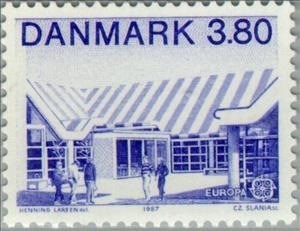Stamp: C.E.P.T.- Modern architecture (Denmark 1987)
C.E.P.T.- Modern architecture (Denmark 1987)
04 May (Denmark ) within release C.E.P.T.- Europe goes into circulation Stamp C.E.P.T.- Modern architecture face value 3.80 Danish krone
| Stamp C.E.P.T.- Modern architecture in catalogues | |
|---|---|
| Michel: | Mi:DK 896 |
| AFA number: | AFA:DK 883 |
Stamp is square format.
Also in the issue C.E.P.T.- Europe:
- Stamp - C.E.P.T.- Modern architecture face value 2.80;
- Stamp - C.E.P.T.- Modern architecture face value 3.80;
Stamp C.E.P.T.- Modern architecture it reflects the thematic directions:
The European Conference of Postal and Telecommunications Administrations (CEPT) was established on June 26, 1959, as a coordinating body for European state telecommunications and postal organizations. The acronym comes from the French version of its name Conférence européenne des administrations des postes et des télécommunications.
The Europa postage stamp (also known as Europa - CEPT until 1992) is an annual joint issue of stamps with a common design or theme by postal administrations of member countries of the European Communities (1956-1959), the European Conference of Postal and Telecommunications Administrations (CEPT) from 1960 to 1992, and the PostEurop Association since 1993. Europe is the central theme. EUROPA stamps underlines cooperation in the posts domain, taking into account promotion of philately. They also build awareness of the common roots, culture and history of Europe and its common goals. As such, EUROPA stamp issues are among the most collected and most popular stamps in the world. Since the first issue in 1956, EUROPA stamps have been a tangible symbol of Europe’s desire for closer integration and cooperation.
Architecture (Latin architectura, from the Greek ἀρχιτέκτων arkhitekton "architect", from ἀρχι- "chief" and τέκτων "builder") is both the process and the product of planning, designing, and constructing buildings and other physical structures. Architectural works, in the material form of buildings, are often perceived as cultural symbols and as works of art. Historical civilizations are often identified with their surviving architectural achievements.
A school is both the educational institution and building designed to provide learning spaces and learning environments for the teaching of students under the direction of teachers. Most countries have systems of formal education, which is sometimes compulsory.In these systems, students progress through a series of schools that can be built and operated by both government and private organization. The names for these schools vary by country (discussed in the Regional terms section below) but generally include primary school for young children and secondary school for teenagers who have completed primary education. An institution where higher education is taught is commonly called a university college or university.





